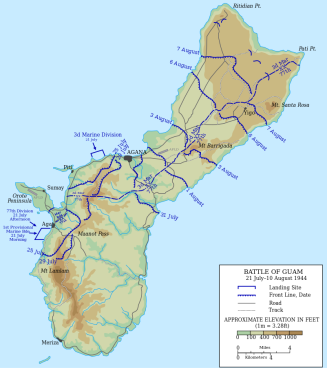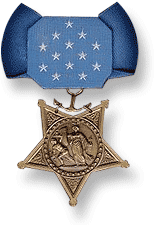Guam was the first US territory captured during World War II. Its garrison of 540 men quickly capitulated to more than 5,000 invading Japanese Marines. Guam subsequently remained under Japanese control for 32 months. During this time, the Japanese military proved itself as a criminal organization capable of unimaginative cruelty. By July 1944, the Japanese command realized that it was running out of time: American forces were poised to take the island back from the Japanese invader. In spite of this, on 15 July 1944, the Japanese Imperial Army rounded up the residents of Merizo, Guam and from their number selected 25 men and 3 women (all school teachers). The Japanese marched these civilians to a nearby cave and once the people were inside the cave, tossed in hand grenades. Fifteen victims survived the ordeal, pretending to be dead. The Japanese repeated this despicable activity the next day, but this time there were no survivors. Throughout the 32 months of occupation, the Japanese forced Guamanian civilians to perform labor, and forced women to provide sexual services for occupying troops.
 Guam’s topography of reef, cliff, heavy surf, and inconceivably dense jungle presented a formidable challenge to the attacking Americans. The assault of the Marianas came under the overall command of Admiral Richmond K. Turner, commanding the US Fifth Fleet, Lieutenant General Holland M. Smith, commanding V Amphibious Corps, and Major General Roy S. Geiger, commanding III Amphibious Corps. The assault on Guam was assigned to Geiger, whose Corps included the US 77th Infantry Division, 3rd Marine Division, Third Corps Artillery, and the 1st Marine Provisional Brigade.
Guam’s topography of reef, cliff, heavy surf, and inconceivably dense jungle presented a formidable challenge to the attacking Americans. The assault of the Marianas came under the overall command of Admiral Richmond K. Turner, commanding the US Fifth Fleet, Lieutenant General Holland M. Smith, commanding V Amphibious Corps, and Major General Roy S. Geiger, commanding III Amphibious Corps. The assault on Guam was assigned to Geiger, whose Corps included the US 77th Infantry Division, 3rd Marine Division, Third Corps Artillery, and the 1st Marine Provisional Brigade.
The battle for Guam took place at the same time as the Tinian campaign, although Tinian drew more national attention. Retaking Guam was a point of honor for the Americans, but strategists also decided that they needed Guam as an advanced naval and air corps base of operations. Initially scheduled for mid-June, military intelligence alerted naval commanders of a Japanese fleet heading directly for the Marianas Islands. Admiral Spruance postponed Guam operations because of the Battle of the Philippine Sea, but the delay allowed American military planners to gain better knowledge of Japanese defenses on Guam.
For the American invasion force, early capture of the Orote Peninsula and Apra Harbor was imperative to secure the use of the harbor and the airfield. This would become the focal point of the attack, and the difficult assignment of seizing the Orote Peninsula falling upon the 1st Marine Brigade, bolstered by the 305th Infantry Regiment. The 3rd Marine Division would make its landing five miles to the north of the Orote Peninsula; initially, the remainder of the US 77th Infantry Division was held in reserve.
The Battle for Guam began at 0530 with overwhelming naval artillery, aerial bombardments, and 4.5-inch rockets, which swept the 14 miles of coastline between Agana to Bangi Point. By 0600, 32 LSTs began to disgorge Marines in LVTs, which promptly stationed themselves 12,000 yards off shore. Marines on transport ships began their dangerous climb down netting into landing craft. Finally, the signal came to advance and Marines began their attack. As they approached the beaches, the Japanese unleashed withering artillery and automatic weapons fire. The fight was on —it resulted in more than 7,000 American casualties, 1,783 of whom were killed in action. Nearly 19,000 Japanese killed during the Battle of Guam.
One participant in this battle was Captain Louis F. Wilson, Jr.,[1] commanding Company F, 2nd Battalion, 9th Marines. Ordered to attack Fonte Hill, Wilson initiated his attack in mid-afternoon. Leading the charge 300 yards through open and rugged terrain, Company F encountered withering machinegun and small arms fire. Toward sundown, Captain Wilson captured his objective and immediately consolidated his position for a night defense.
The Fonte Plateau was the location of one of the bitterest struggles during the Guam campaign. Localized counterattacks flared all along the front of the 2nd Battalion and caused a constant drain on the Marines. At one point, it was necessary to pull Captain Wilson’s company back some 50 yards from its salient in order to consolidate the battalion defense. There was no let up in the pressure and the Marines were expending ammunition at an alarming rate. Seven major counterattacks ate away at the American line, but the Marines held, even by the slimmest margin.
Although wounded three times during the initial assault, Captain Wilson continued to lead his Marines while repelling fanatical enemy counterattacks throughout the night. Wilson continually exposed himself to the merciless hail of fire and shrapnel, which the enemy rained down upon him and his men. On one occasion, Captain Wilson dashed through fifty yards of intense enemy fire in order to rescue a fallen Marine.
 The height of the battle was reached in the early morning hours when the Japanese seemed to come in unending waves and the din of weapons firing all at once mixed with the screams and yells of men caught up in the frenzy of close-quarter combat. As the first faint outline of dawn appeared on the horizon, the Marines realized that they were nearly out of ammunition.
The height of the battle was reached in the early morning hours when the Japanese seemed to come in unending waves and the din of weapons firing all at once mixed with the screams and yells of men caught up in the frenzy of close-quarter combat. As the first faint outline of dawn appeared on the horizon, the Marines realized that they were nearly out of ammunition.
As the morning sun peeked over the hilly terrain, Captain Wilson organized a 17-man combat patrol to push forward and seize the vital high ground in his sector of operations. Boldly defying intense enemy fire, Captain Wilson succeeded in capturing and holding terrain vital to the regiment’s success. In front of F Company’s position lay 350 dead Japanese infantry. For this action, Captain Wilson received the Medal of Honor.
Notes:
[1] Lou Wilson (also known as Chilly Willy) served as the 26th Commandant of the Marine Corps (1975-1979). He passed away on 21 June 2005 at the age of 85.

Not too long after its capture, didn’t Guam become the advanced headquarters for Admiral Nimitz and other commanders as well as an important base for supplies?
LikeLike
LikeLiked by 1 person
I had the honor to command F/2/9 many years later (1976-7). It was in Okinawa, though we did training at Camp Fuji (twice) and an Exercise in Korea. Later the Battalion, on a number of ships, sailed to various ports….we (F/2/9 with a battery of 105 mm howitzers and one platoon of tanks) aboard the USS FORT FISHER (LSD-40) sailed to Singapore for great liberty….and Equator “festivities”.
While I was CO of Fox 2/9, we were also honored to have (then) GySgt Paul Kellog as the Company Gunny. He is a recipient of the Medal of Honor for service in Vietnam.
I first went to Guam circa 1959 and it was not so much. Years later we flew into the place and it has mega high rise buildings and, believe it or not, is a honeymoon destination for Japanese nationals.
A bit more of irony in the world.
LikeLike
Reblogged this on First Night History.
LikeLike
Thank you.
LikeLike
No battle should be forgotten – whether it be small or on a major scale. Men fought and died for their countries. Atrocities should also be remembered in hopes such things do not happen again but unfortunately, they continue. Thank you for bringing these stories back into the spotlight.
Although not Marines, Guam was the home of the 20th AF. Many firebombing missions took off from Guam, one being the longest flight time for a WWII mission. At war’s end, rescue flights took off, dropping critical supplies over POW camps. None of this would have been possible without the spirit of the US Marine Corps.
LikeLike